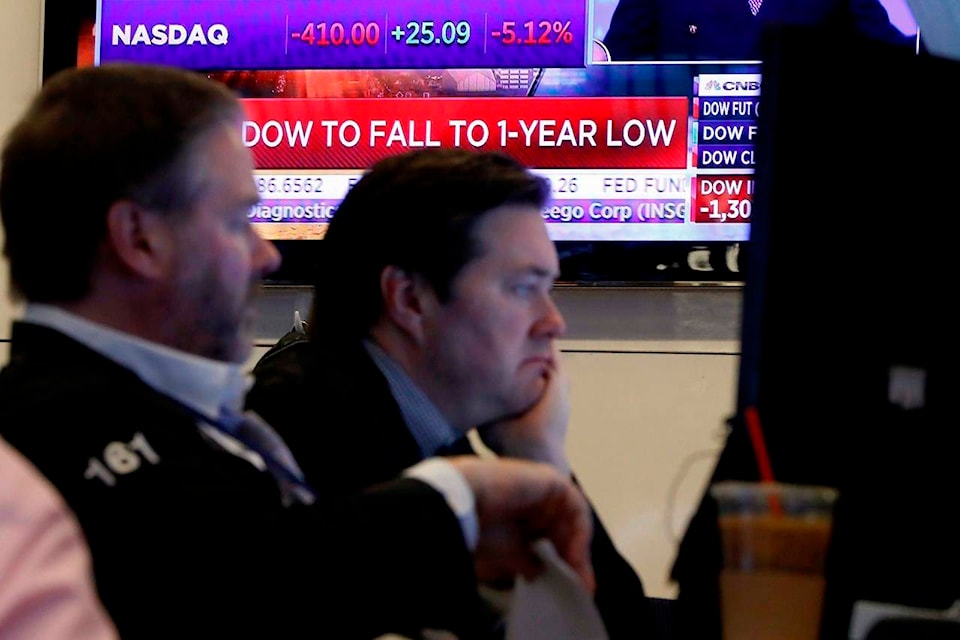Stocks went into a steep slide Monday on Wall Street as a combination of coronavirus fears and a crash in oil prices spread alarm through the market, triggering the first automatic halt in trading in over two decades to let investors catch their breath.
The price of oil sank nearly 20% after Russia refused to roll back production in response to falling demand and Saudi Arabia signalled it will ramp up its own output. While low oil prices can translate into cheaper gasoline, they wreak havoc on energy companies and countries that count on petroleum revenue, including the No. 1 producer, the U.S.
The clash between the two giant oil producers came as Italy — the country hit hardest by the coronavirus in Europe — began enforcing a lockdown against 16 million people in the north, the heart of its manufacturing and financial industries. The turmoil is expected to push Italy into recession and weigh on the European economy.
U.S. stocks edged closer to a bear market, defined as a drop of 20% from a record, while a gauge of fear on Wall Street reached its highest level since the 2008 global financial crisis.
European markets entered a bear market, closing the day with their heaviest losses since the darkest days of the 2008 meltdown. Italy’s index plunged 11.2%. Britain, France and Germany were down between 7.3% and 8.4%
Yields on U.S. Treasury bonds plunged to more record lows as investors kept on sinking money into seemingly safer places, even as the return on their investment sank closer and closer to nothing.
ALSO READ: COVID-19 concerns up odds Bank of Canada will cut rates, economists say
On Wall Street, the S&P 500 plunged 7.4% in the first few minutes after the opening bell before trading was halted by the market’s circuit breakers, first adopted after the crash of October 1987 and modified over the years. After the 15-minute pause, stocks trimmed their losses but were still down 5.7% in the early afternoon.
The Dow Jones Industrial Average lost 1,593 points, or 6.2%, to 24,275 after briefly being down more than 2,000. The Nasdaq gave up 5.1%.
The market-wide circuit breakers have been triggered only once before, in 1997.
The carnage in the energy sector was particularly bad. With benchmark U.S. crude dropping to under $34 a barrel, Marathon Oil, Apache Corp. and Diamondback Energy each sank more than 40%. Exxon Mobil and Chevron were on track for their worst days since 2008.
“We knew it was going to be a hot day,” said John Spensieri, head of U.S. equity trading at Stifel. He said that the mood was “organized chaos” in the morning but that the trading halt achieved what it was supposed to by stopping the slide.
The coronavirus has infected more than 110,000 people worldwide and killed around 3,900, leading to factory shutdowns, travel bans, closings of schools and stores, and cancellations of conventions and other gatherings.
ALSO READ: Toilet paper panic hits Greater Victoria as shoppers prep for threat of COVID-19
While the crisis has eased in China, where the virus was first detected, fast-growing clusters have turned up in South Korea, Iran and Italy, and fears are mounting in the United States, where a giant cruise ship idling off the California coast with at least 21 infected people aboard was scheduled to dock in Oakland on Monday so that the thousands on the vessel could be whisked to U.S. military bases or their home countries for a 14-day quarantine.
After initially taking an optimistic view on the virus — hoping that it would remain mostly in China and cause just a short-term disruption — investors are realizing they probably underestimated the crisis badly.
Including Monday’s drop, the S&P 500 has now lost 18% since setting a record last month. If it hits a 20% drop, it would mean the death of what’s become the longest-running bull market for U.S. stocks in history, an 11-year run. Monday marks the 11th anniversary of the market hitting bottom after the 2008 financial crisis.
The yield on the 10-year Treasury note plunged to 0.59%. Early last week, it had never been below 1%.
Traders are increasing betting that the Federal Reserve will cut interest rates back to zero to do what it can to help the virus-weakened economy, perhaps as soon as next week.
But doubts are rising about how effective lower rates can be this time. They can encourage people and companies to borrow, but they can’t restart factories, restaurants or theme parks shut down because people are quarantined.
The Fed has already cut its benchmark short-term rate to a range of 1% to 1.25%, leaving little room to cut more.
“Central banks are a bit player in the current crisis,’’ Ethan Harris, global economist at Bank of America, wrote in a research report.
The clamour is growing louder for help from authorities besides central banks.
“Today’s market action may bang some heads together and actually start thinking about the constructive measures the government can take,’’ said Jacob Kirkegaard, senior fellow at the Peterson Institution for International Economics.
Among other things, Kirkegaard said, the government should make sure all Americans get paid sick leave and health care coverage for virus-related ills.
___
AP Business Writer Damian J. Troise and AP Economics Writer Paul Wiseman contributed.
Stan Choe, The Associated Press
